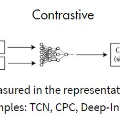Recommending cold-start items is a long-standing and fundamental challenge in recommender systems. Without any historical interaction on cold-start items, CF scheme fails to use collaborative signals to infer user preference on these items. To solve this problem, extensive studies have been conducted to incorporate side information into the CF scheme. Specifically, they employ modern neural network techniques (e.g., dropout, consistency constraint) to discover and exploit the coalition effect of content features and collaborative representations. However, we argue that these works less explore the mutual dependencies between content features and collaborative representations and lack sufficient theoretical supports, thus resulting in unsatisfactory performance. In this work, we reformulate the cold-start item representation learning from an information-theoretic standpoint. It aims to maximize the mutual dependencies between item content and collaborative signals. Specifically, the representation learning is theoretically lower-bounded by the integration of two terms: mutual information between collaborative embeddings of users and items, and mutual information between collaborative embeddings and feature representations of items. To model such a learning process, we devise a new objective function founded upon contrastive learning and develop a simple yet effective Contrastive Learning-based Cold-start Recommendation framework(CLCRec). In particular, CLCRec consists of three components: contrastive pair organization, contrastive embedding, and contrastive optimization modules. It allows us to preserve collaborative signals in the content representations for both warm and cold-start items. Through extensive experiments on four publicly accessible datasets, we observe that CLCRec achieves significant improvements over state-of-the-art approaches in both warm- and cold-start scenarios.
翻译:推荐冷启动项目是建议系统的长期和根本挑战。在冷启动项目上没有任何历史互动,CF计划没有使用协作信号来推断用户对这些项目的偏好。为了解决这个问题,已经进行了广泛的研究,以便将侧面信息纳入冷启动项目计划。具体地说,它们采用现代神经网络技术(例如,辍学、一致性限制)来发现和利用内容特性和协作演示之间的联合效应。然而,我们认为,这些方法不太能探索内容特点和协作演示之间的相互依存性,缺乏足够的理论支持,从而造成不令人满意的业绩。在这项工作中,我们从信息理论角度重新确定冷启动项目展示,学习项目内容和协作信号之间的相互依存性。具体地说,它们采用现代神经网络技术(例如,辍学、一致性限制)来发现和利用内容特性和协作演示之间的联合效应。然而,我们用这种协作嵌入和特征描述项目之间的相互信息,我们根据对比学习的对比性学习过程设计了新的目标功能,并开发一个简单而有效的冷启动的冷启动项目,在冷启动轨道上,在冷启动的升级的实验室中,在冷启动的升级的三层上,在冷启动的升级的实验室中,在C中,进行冷启动的升级的升级的升级的演示中,在C中,使学习的升级的三部(C)建议框架框架中,在C)中,在冷启动的升级的升级的构建了。




